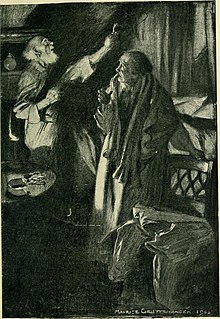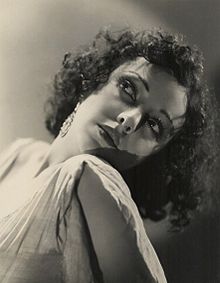The Monkey's Paw
This article needs additional citations for verification. (April 2015) |
| "The Monkey's Paw" | |
|---|---|
| Short story by W. W. Jacobs | |
| Country | England |
| Language | English |
| Genre(s) | Horror, short story |
| Publication | |
| Publication date | September 1902 |
"The Monkey's Paw" is a supernatural short story by author W. W. Jacobs first published in England in 1902.
In the story, three wishes are granted to the owner of the monkey's paw, but the wishes come with an enormous price for interfering with fate.
Plot

The short story involves Mr. and Mrs. White and their adult son, Herbert. Sergeant-Major Morris, a friend who served with the British Army in India, introduces them to a mummified monkey's paw. An old fakir placed a spell on the paw, that it would grant three wishes to three separate men. The wishes are granted but always with hellish consequences, as punishment for tampering with fate. Morris tells the Whites of his comrade, who used his third wish to wish for death. Morris, also having had a horrific experience upon using the paw, throws the monkey's paw into the fire but Mr. White retrieves it. Before leaving, Morris warns Mr. White that if he does use the paw, then be it on his own head.
At Herbert's suggestion, Mr. White wishes for £200 to be used as the final payment on his house, even though he believes he has everything he wants. The next day his son Herbert leaves for work at a local factory. Later that day, word comes to the White home that Herbert has been killed in a terrible machinery accident. Although the employer denies responsibility for the incident, the firm makes a goodwill payment to family of the deceased. The payment is £200.
Ten days after their son's death and a week after the funeral, Mrs. White, almost mad with grief, asks her husband to use the paw to wish Herbert back to life. Reluctantly, he does so. Shortly afterwards there is a knock at the door. As Mrs. White fumbles at the locks in an attempt to open the door Mr. White, who had to identify his son's mutilated body, and who knows the corpse has been buried for more than a week, realizes that the thing outside is not the son he knew and loved, and makes his third wish.
The knocking suddenly stops. Mrs. White opens the door to find no one is there.
Themes
Understanding the themes of "The Monkey's Paw" is contingent upon pretending that the fate represented through the supernatural story is as indifferent as it seems. The characters' lives depend on that indifferent fate that both rewards and punishes people despite morals or lack thereof. The simple desires of the characters are twisted by the monkey's paw and turned into horrible consequences, not due to the faults of the characters, but rather due to the indifference of fate itself. The payment that Mr. White attains for his son's death is the exact sum that he requested to make the final payment on his house - thus, his reasonable desire was met by a terrible consequence. The characters are normal people with normal reactions and normal desires, but those normal desires cause their downfall because of the indifferent fate that governs them.
The short story also bears the adage "Be careful what you wish for." The characters focus on what they desire, and make their wishes without thinking them through or considering the consequences of tampering with fate. Thus, their wishes are granted, but because they alter fate their lives take a sharp turn in a horrible direction.[1]
Versions in other media

The story has been adapted into other media many times, including:
- On 6 October 1903, a one-act play opened at London's Haymarket Theatre, starring Cyril Maude as Mr. White and Lena Ashwell as Mrs. White.[2]
- A 1910 stage adaptation by Louis N. Parker.[3]
- A 1915 film version, directed by Sidney Northcote and starring John Lawson.[4]
- A 1923 film version, directed by Manning Haynes and starring Moore Marriott, Marie Ault, and Charles Ashton.[4]
- A July 17, 1928 UK radio adaptation based on the 1910 play.[3]
- A 1933 film version, screenplay by Graham John, directed by Wesley Ruggles (his last film with RKO), and starring C. Aubrey Smith, Ivan Simpson and Louise Carter.[5]
- A 1939 UK television adaptation produced by Moultrie Kelsall.[3]
- A May 28, 1946 episode of the BBC Radio series Appointment with Fear.[3]
- A 1948 film version, screenplay by Norman Lee and Barbara Toy.[6]
- A December 16, 1958 episode of the UK radio series Thirty-Minute Theatre, starring Carleton Hobbes and Gladys Young.[3]
- A 1961 film version called Espiritismo (released as Spiritism in the US), directed by Benito Alazraki and starring Nora Veyran, Jose Luis Jiminez, and Jorge Mondragon.[4]
- "The Monkey's Paw – A Retelling", aired on TV on April 19, 1965 in season 3, episode 26 of The Alfred Hitchcock Hour, starring Leif Erickson, Jane Wyatt, and Lee Majors.
- A July 11, 1980 episode of the CBC Radio series Nightfall.[3]
- A January 17, 1988 BBC Radio adaptation by Patrick Galvin, presented as part of Fear on Four. It was rebroadcast individually as a Halloween special on October 31, 1993.[3]
- A one-act opera of the story was adapted by composer Stephen J. Grieco in 1996 and premiered at the Alice E. Bartlett Theatre.[7]
- A 2004 adaptation as a radio play narrated by Christopher Lee in 2004 as part of the BBC radio drama series Christopher Lee's Fireside Tales.[8]
- A 2008 adaptation as Nepali movie Kagbeni, directed by Bhusan Dahal and starring Nima Rumba, Saugat Malla, and Deeya Maskey. A few changes were made to adjust with the locality.
- An operatic version of the story was adapted by composer Jonathan N. Kupper in 2009. Excerpts of the piece were showcased as part of Opera Vista's new opera competition in Houston, Texas in 2010; and a full production was premiered by The Microscopic Opera Company in Pittsburgh, Pennsylvania in 2011.[9]
- A 2011 Australian radio adaptation on The Drama Pod.[3]
Variations and parodies
A great number of novels, stories, movies, plays and comics are variations or adaptations of the story, featuring similar plots built around wishes that go awry in macabre ways, occasionally with references to monkey's paws or to the story itself.
The story is frequently parodied on television shows and in comic books.
See also
References
- ^ "The Monkey's Paw Themes - eNotes.com". eNotes. Retrieved 15 November 2016.
- ^ Jacobs, W. W.; Parker, Louis N. (1910). The Monkey's Paw: A Story in Three Scenes. London: Samuel French, Ltd. p. 5.
- ^ a b c d e f g h Richard J. Hand (5 June 2014). Listen in Terror: British Horror Radio from the Advent of Broadcasting to the Digital Age. Oxford University Press. pp. 35–36. ISBN 978-0-7190-8148-4.
- ^ a b c Alan Goble (1 January 1999). The Complete Index to Literary Sources in Film. Walter de Gruyter. p. 241. ISBN 978-3-11-095194-3.
- ^ Jewell, Richard B.; Harbin, Vernon (1982). The RKO Story. New York: Arlington House. p. 57. ISBN 0-517-546566.
- ^ Soister, John T. (2004). Up from the Vault: Rare thrillers of the 1920s and 1930s. McPharland. p. 133.
- ^ "Alice E. Bartlett, SUNY Fredonia".
- ^ "BBC Radio 4 Extra - Christopher Lee's Fireside Tales, The Monkey's Paw". BBC.
- ^ "microscopic-opera". microscopic-opera.
External links
 The Monkey's Paw public domain audiobook at LibriVox
The Monkey's Paw public domain audiobook at LibriVox- "The Monkey's Paw"; Full Short Story Text
- Gaslight edition of the story
- Monkey's Paw Radio Play
- Podcast of "The Monkey's Paw" as read by John Lithgow
- Books That Grow leveled book
